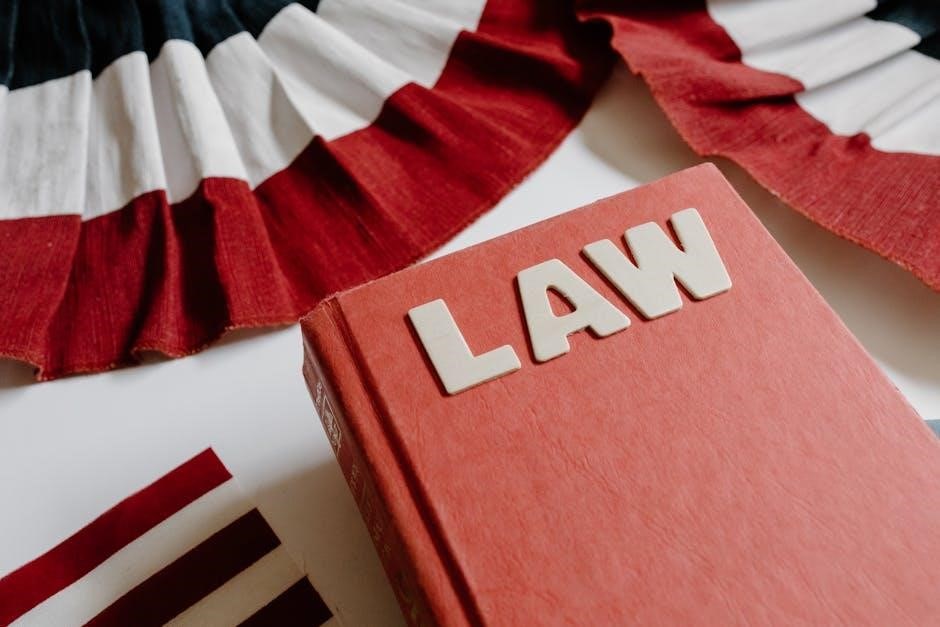Unit 1 introduces the foundational principles and frameworks of American democracy, setting the stage for understanding governance, rights, and civic engagement in the AP Government curriculum.
1.1 Overview of Unit 1
Unit 1 provides a comprehensive introduction to the foundational principles of American democracy, focusing on key documents, structures, and ideologies that shape U.S. governance. It explores the Declaration of Independence, Articles of Confederation, and the Constitution, emphasizing their historical context and significance. Additionally, the unit covers essential concepts such as federalism, separation of powers, and civil liberties, laying the groundwork for understanding the framework of American government. This section is crucial for building a strong foundation in AP Government, as it sets the stage for analyzing more complex topics in later units.
1.2 Importance of Understanding Foundations of American Democracy
Understanding the foundations of American democracy is crucial for grasping the evolution and functioning of the U.S. government. It provides insight into the core principles of liberty, equality, and justice, which shape public policy and civic engagement. By studying key documents and ideologies, students develop a framework for analyzing the structure of government, the role of individual rights, and the dynamics of power distribution. This knowledge is essential for evaluating contemporary political issues and participating thoughtfully in civic life, making it a cornerstone of the AP Government curriculum.
1.3 Key Themes and Concepts
The study of AP Government Unit 1 revolves around foundational themes such as democratic principles, the rule of law, and the balance of power. Central concepts include the origins of American government, the role of key documents, and the evolution of political ideologies. These themes provide a framework for understanding how the U.S. government operates and how it has developed over time.
Key concepts also encompass the ideas of federalism, separation of powers, and individual rights, which are essential for analyzing the structure and function of the government. These themes and concepts lay the groundwork for deeper exploration in subsequent units.
The Founding Documents
The Founding Documents form the bedrock of American governance, outlining core principles and structures that shape the nation’s political framework, law, and enduring democratic values.
2.1 The Declaration of Independence
The Declaration of Independence, adopted in 1776, formally declared the 13 colonies’ independence from Great Britain. It established the fundamental principles of natural rights, individual liberties, and self-governance, shaping America’s identity. Penned by Thomas Jefferson, it outlined grievances against King George III, emphasizing consent of the governed and the right to alter or abolish oppressive governments. This document not only announced the birth of a new nation but also inspired democratic movements worldwide, embedding Enlightenment ideals into the foundation of American political thought and practice.
2.2 The Articles of Confederation
The Articles of Confederation, ratified in 1781, served as the first constitution of the United States during the Revolutionary War. It established a weak central government with limited powers, primarily focused on national defense and foreign policy. Each state retained significant sovereignty, and decisions required unanimous consent, leading to inefficiency. The Articles prohibited the federal government from taxing, regulating commerce, or enforcing laws, resulting in economic and diplomatic challenges. These shortcomings highlighted the need for a stronger federal system, ultimately leading to the Constitutional Convention of 1787 and the creation of the U.S. Constitution.
2.3 The Constitution
The Constitution, adopted in 1787 and ratified in 1788, is the supreme law of the United States. It established the framework of the federal government, dividing power among the legislative, executive, and judicial branches. The document outlines the principles of federalism, separation of powers, and checks and balances to prevent any single entity from abusing authority. It also provides the process for amending laws and ensures the continuation of government. The Constitution’s preamble emphasizes its purpose: to establish justice, ensure domestic tranquility, provide for the common defense, promote general welfare, and secure liberty for citizens.

The Constitution
The Constitution is the foundational document of the U.S. government, establishing its structure, powers, and principles while ensuring stability and adaptability through its framework and amendments.
3.1 The Constitutional Convention
The Constitutional Convention, held in 1787, aimed to address weaknesses in the Articles of Confederation. Key Founders like Madison, Hamilton, and Washington attended, bringing diverse perspectives. The Virginia Plan proposed a strong central government, while the New Jersey Plan favored equal state representation. The Great Compromise established a bicameral legislature, balancing both approaches. Debates over slavery and state powers led to the Three-Fifths Compromise. Despite challenges, the convention produced a foundational document that would shape the U.S. government, reflecting principles of federalism and representation.
3.2 The Ratification Debate
The Ratification Debate was a pivotal period following the Constitutional Convention, as states decided whether to adopt the new Constitution. Federalists, who supported ratification, argued that a strong central government was essential for national unity and effective governance. Anti-Federalists opposed it, fearing it would erode state sovereignty and individual liberties. Key Federalists like Madison, Hamilton, and Jay penned the Federalist Papers to counter these concerns. The debate led to compromises, including the promise of a Bill of Rights, which helped secure ratification. This contentious process highlighted the importance of balancing power and protecting rights.
3.3 The Structure and Purpose of the Constitution
The Constitution is divided into a Preamble, seven Articles, and the Bill of Rights. The Preamble outlines its purpose: to establish justice, ensure tranquility, provide defense, promote welfare, and secure liberty. The Articles define the structure of the federal government, including separation of powers and the system of federalism. The Constitution establishes a framework for governance, balancing individual rights with governmental authority. Its structure ensures stability, unity, and adaptability, allowing it to endure as the foundation of the U.S. legal and political system through amendments and interpretations over time.

Key Principles of the Constitution
This section explores the fundamental principles of the Constitution, including federalism, separation of powers, checks and balances, and individual rights, which organize government and protect liberties.
4.1 Federalism
Federalism is a cornerstone of the U.S. Constitution, dividing power between the federal government and state governments. This system of dual sovereignty ensures that both levels of government operate independently yet collaboratively. The federal government holds authority over matters like foreign policy, defense, and interstate commerce, while states retain control over local issues such as education and law enforcement. The Supremacy Clause and the 10th Amendment solidify this framework, preventing either level from dominating the other. Federalism promotes balance, prevents tyranny, and allows for policy innovation at the state level, fostering a dynamic governance structure.
4.2 Separation of Powers
The separation of powers is a constitutional principle dividing government authority into three branches: legislative, executive, and judicial. This division prevents any single branch from dominating, safeguarding against tyranny. The legislative branch, Congress, enacts laws. The executive branch, led by the President, enforces them. The judicial branch interprets laws, ensuring they align with the Constitution. Checks and balances further restrain power, allowing each branch to limit the others’ actions, fostering accountability and maintaining a balanced and equitable governance system.
4.3 Checks and Balances
Checks and balances are mechanisms ensuring that no branch of government exceeds its authority. Congress can impeach the President, approve Supreme Court justices, and control funding. The President can veto legislation and appoint federal judges. The judiciary can declare laws unconstitutional through judicial review. These interlocking powers prevent dominance by any single branch, promoting accountability and maintaining constitutional equilibrium. This system ensures that power remains distributed evenly, safeguarding individual rights and upholding democratic principles.

The Bill of Rights
The Bill of Rights, comprising the first ten amendments, protects individual freedoms, ensuring liberties like free speech, religion, and the right to bear arms, while limiting government overreach.
5.1 The First Amendment
The First Amendment safeguards fundamental freedoms, including religion, speech, press, assembly, and petition. It prohibits Congress from establishing a religion or impeding its free exercise, ensuring separation of church and state. Freedom of speech protects expression, even controversial ideas, while freedom of the press ensures a free flow of information. The right to assemble and petition allows citizens to voice dissent and seek change. These liberties are essential to democracy, fostering individual rights and government accountability. Supreme Court interpretations have expanded and refined these protections, ensuring they remain vital in modern society.
5.2 The Second Amendment
The Second Amendment guarantees the right to bear arms, a contentious issue in American politics. It states, “A well-regulated Militia, being necessary to the security of a free State, the right of the people to keep and bear Arms, shall not be infringed.” Historically, it was tied to militia service and self-defense. Modern debates focus on individual gun rights versus public safety. Supreme Court rulings, such as District of Columbia v. Heller, have upheld individual rights to possess firearms, but ongoing disputes over regulation and interpretation persist, reflecting broader societal divisions over gun control.
5.3 The Remaining Amendments
Beyond the First and Second Amendments, the Bill of Rights includes 12 additional amendments addressing various rights and limitations on government power. The Third Amendment restricts quartering soldiers in private homes, while the Fourth protects against unreasonable searches and seizures. The Fifth guarantees due process and protects against self-incrimination. The Sixth ensures a speedy trial, the Seventh preserves trial by jury, and the Eighth prohibits cruel and unusual punishment. The Ninth and Tenth Amendments emphasize individual rights and state sovereignty. Later amendments, like the 13th (abolishing slavery) and the 19th (women’s suffrage), expanded civil rights. The 26th Amendment lowered the voting age to 18, and the 27th, ratified in 1992, limits congressional pay raises. These amendments collectively shape American civil liberties and governance.

Federalism in Practice
Federalism in practice involves the division of power between federal and state governments, ensuring shared governance and regional autonomy while maintaining national unity.
6.1 Dual Federalism
Dual federalism refers to a system where federal and state governments operate in separate, distinct spheres of authority with little overlap. This framework, prominent in the 19th century, divided powers clearly, with the federal government handling national issues like foreign policy and defense, while states managed local matters such as education and law enforcement. The idea was rooted in the belief that both levels of government could function independently without interference. Dual federalism was reinforced by Supreme Court decisions that upheld state authority, but it began to erode in the 20th century with the expansion of federal power and the New Deal.
6.2 Cooperative Federalism
Cooperative federalism emphasizes collaboration between federal and state governments, with shared responsibilities and funding for joint programs. This approach emerged in the 20th century as federal authority expanded, particularly during the New Deal era. Programs like Medicaid and transportation projects require both levels of government to work together, blending their resources. Cooperative federalism promotes efficiency and addresses complex issues that span state borders, fostering a more unified system. However, it can lead to tensions when federal mandates require state compliance without full funding, straining state budgets and causing intergovernmental conflicts.
6.3 New Federalism
New federalism shifts power from the federal government to states, emphasizing decentralization and state sovereignty. This approach, prominent since the late 20th century, particularly during the Reagan era, aims to reduce federal involvement and delegate more authority to state and local governments. It often involves block grants, allowing states flexibility in funding allocation, unlike restrictive categorical grants. This system enables states to address specific needs tailored to their populations. However, it risks inequality, as wealthier states may provide superior services compared to poorer ones. Critics argue it could lead to a patchwork of policies and disadvantage certain groups, while proponents highlight localized decision-making efficiency. New federalism reflects conservative ideals of smaller government and practical considerations for better governance, though it faces challenges in adequate funding and potential disparities.

Civil Liberties and Civil Rights
Civil liberties and civil rights are fundamental to American democracy, ensuring individual freedoms and equal protection under the law, with the judiciary playing a crucial interpretive role.
7.1 The Fourteenth Amendment
The Fourteenth Amendment, ratified in 1868, defines citizenship, ensures equal protection under the law, and prohibits states from denying due process. It abolished slavery’s remnants, granting former slaves citizenship and rights. The amendment significantly expanded federal authority over states, requiring them to adhere to constitutional safeguards. Its “equal protection” clause has been pivotal in landmark civil rights cases, such as Brown v. Board of Education and Obergefell v. Hodges, shaping modern interpretations of equality and justice in America. It remains a cornerstone of civil liberties and rights, influencing countless legal decisions;
7.2 Landmark Supreme Court Cases
Landmark Supreme Court cases have shaped civil liberties and civil rights, interpreting the Constitution’s guarantees. Cases like Marbury v. Madison established judicial review, while Brown v. Board of Education dismantled segregation. Roe v. Wade addressed abortion rights, sparking ongoing debates. These decisions reflect evolving interpretations of equality, due process, and individual freedoms, influencing societal norms and legal frameworks; They underscore the judiciary’s role in resolving constitutional disputes, ensuring the Constitution remains a living document responsive to changing American values and challenges.
7.3 Modern Civil Rights Issues
Modern civil rights issues continue to evolve, addressing ongoing disparities and injustices. Racial inequities, particularly in policing and criminal justice, remain central concerns. Voter suppression and gerrymandering also pose challenges to equitable political representation. LGBTQ+ rights, including marriage equality and anti-discrimination protections, are key areas of debate. Additionally, systemic inequalities in education, housing, and economic opportunities persist, highlighting the intersectional nature of civil rights. Movements like Black Lives Matter have brought renewed attention to these issues, sparking calls for legislative and societal reforms to ensure true equality and justice for all.

Political Ideologies
Political ideologies are systems of beliefs shaping attitudes toward government, economy, and society, influencing policy preferences and voting behavior, central to understanding the American political landscape.
8.1 Liberalism
Liberalism emphasizes individual freedoms, social equality, and government intervention to address societal issues. It advocates for progressive policies, such as social welfare programs and environmental regulations, to promote the common good. Rooted in Enlightenment ideas, liberalism supports civil rights, free markets with oversight, and a robust federal government to ensure opportunities for all. In modern politics, liberals often prioritize education, healthcare, and climate action. The ideology contrasts with conservatism, focusing on change and inclusivity, while its classical form stressed limited government and property rights, evolving over time to address contemporary challenges in American democracy.
8.2 Conservatism
Conservatism prioritizes preserving traditional values, institutions, and limited government intervention. It emphasizes individual responsibility, free enterprise, and the protection of property rights. Rooted in the American Revolution, conservatism opposes drastic societal changes, advocating for gradual reforms. It often aligns with beliefs in a strong national defense, states’ rights, and religious values. In contrast to liberalism, conservatives typically support lower taxes, deregulation, and a smaller federal government. Modern conservatism also focuses on cultural issues, such as family values and law enforcement support. This ideology seeks to maintain stability and order, reflecting a cautious approach to societal progress and governance.
8.3 Other Ideologies
Beyond liberalism and conservatism, other ideologies shape American political thought. Libertarianism advocates for maximum individual freedom and minimal government intervention, prioritizing civil liberties and free markets. Socialism emphasizes economic equality, often supporting government regulation and public services to reduce wealth disparities. Populism focuses on empowering ordinary people, often criticizing elites and promoting direct democracy. These ideologies, while less dominant, influence policy debates and voter alignment. Understanding them provides a broader perspective on the diverse beliefs within the American political landscape, highlighting the complexity of public opinion and governance.
Political Participation
Political participation is essential for democracy, enabling citizens to influence governance through voting, joining parties, and advocating policies that reflect their interests and shape democracy effectively.
9.1 Voter Behavior
Voter behavior examines why individuals vote as they do, influenced by factors like party affiliation, ideology, demographics, and candidate characteristics. Incumbency advantage often plays a role, as do campaign strategies and current events. Economic conditions, social issues, and voter turnout rates also shape decisions. Understanding voter behavior helps explain election outcomes and the effectiveness of political campaigns. It highlights how diverse factors interact to influence choices at the polls, reflecting broader societal trends and political engagement levels among different groups.
9.2 Political Parties
Political parties play a central role in organizing and shaping the political process. They serve as vehicles for expressing ideologies, mobilizing voters, and contesting elections. Major parties, such as Democrats and Republicans, dominate U.S. politics, while third parties often struggle for visibility. Parties influence policy agendas, voter alignment, and government operations. Their platforms reflect core values, guiding candidates and policymakers. Party identification strongly impacts voter behavior, with independents increasingly influencing election outcomes. The two-party system persists due to structural factors like winner-take-all elections, while third parties occasionally disrupt the status quo.
9.3 Interest Groups
Interest groups are organizations that represent specific interests and aim to influence public policy. They differ from political parties by focusing on particular issues rather than electing candidates. These groups employ various methods such as lobbying, campaign contributions, and grassroots efforts to shape policy. Political Action Committees (PACs) are a key tool for interest groups to support aligned candidates financially. Interest groups operate at federal, state, and local levels, adapting strategies based on where decision-making occurs. Their effectiveness varies, with larger groups often having more influence, but dedicated grassroots organizations can also impact local issues. Critics argue that interest groups may lead to undue influence by special interests, potentially favoring specific groups over the general public. However, they can also amplify marginalized voices and ensure diverse perspectives in policymaking. Examples include the NRA, Sierra Club, business groups, and labor unions, each with distinct goals but shared aims to influence policy. Success for interest groups can be measured through legislation passage, public opinion shifts, or candidate elections. Funding is crucial for their activities, but smaller groups can still make an impact through strategic efforts. Interest groups may collaborate on aligned issues or compete for influence, navigating the political landscape to achieve their objectives. Overall, interest groups enhance representation but also raise concerns about policy fairness and influence equality.

Public Opinion
Public opinion reflects collective citizen attitudes on political issues, shaping governance by influencing leaders and policy decisions. It is shaped by media, education, and personal experiences, measured through polls and surveys to analyze trends and understand societal views.
10.1 Measuring Public Opinion
Measuring public opinion involves various methods, including polls, surveys, focus groups, and exit polls, to gauge citizen attitudes on political issues. Polls are the most common tool, using representative samples to infer broader opinions. Surveys collect detailed data through structured questionnaires, while focus groups provide qualitative insights. Exit polls measure voter behavior post-election. These methods aim to capture accurate representations, though challenges like sampling bias, question wording, and response rates can affect reliability. Understanding these techniques is crucial for analyzing public sentiment in democracy.
10.2 Influences on Public Opinion
Public opinion is shaped by various factors, including family, education, social environment, and media. Cultural and societal norms also play a significant role. Political leaders and events influence attitudes, as do personal experiences and economic conditions. Media, particularly news outlets, can frame issues and sway opinions through selective reporting. Additionally, peer groups and social networks reinforce or challenge existing beliefs. Understanding these influences is essential for grasping how public opinion forms and evolves over time, impacting political decisions and civic engagement.
10.3 The Role of Media
The media plays a critical role in shaping public opinion by disseminating information, framing issues, and holding those in power accountable. It acts as a bridge between the government and the public, influencing perceptions of policies and political figures. Through agenda-setting, the media highlights certain issues, making them more salient to the public. However, challenges like bias, misinformation, and sensationalism can distort public understanding. The rise of social media and 24-hour news cycles has further transformed how information is consumed, often amplifying polarizing narratives and shaping political engagement.

The Media and Politics
The media significantly influences political processes by reporting news, shaping public opinion, and holding officials accountable. It bridges communication between governments and citizens, impacting policy perceptions and engagement.
11.1 The Evolution of Media in Politics
The media’s role in politics has transformed significantly over time. From traditional print and broadcast media to the rise of digital platforms, the way information is disseminated has evolved. The 19th century saw newspapers as primary sources of political news, while the 20th century brought television, shaping public opinion through visual storytelling. The internet and social media revolutionized political communication, enabling instant access to information and fostering citizen journalism. This evolution has reshaped how politicians campaign, govern, and engage with the public, creating both opportunities and challenges for democracy.
11.2 The Impact of Social Media
Social media has profoundly influenced modern politics, enabling rapid information dissemination and direct communication between politicians and citizens. Platforms like Facebook, Twitter, and Instagram have transformed how campaigns are run, with targeted ads and viral content shaping public opinion. Social media fosters engagement but also amplifies polarization through echo chambers and misinformation. It has become a critical tool for political activism, allowing movements to mobilize support swiftly. However, its role in spreading fake news and manipulating opinion highlights the challenges of balancing its benefits and drawbacks in a democratic society.
11.3 Media Bias and Its Effects
Media bias refers to the perceived or actual slant in news reporting, often favoring a particular ideology or viewpoint. This can influence public perception and trust in media institutions. Bias may manifest as selective reporting, framing, or omission of certain stories, potentially shaping voter opinions and political outcomes. While some argue bias is inherent, others contend it undermines democratic discourse. The rise of partisan media outlets has intensified polarization, making it difficult for citizens to access balanced information. Addressing bias remains critical to maintaining a well-informed and engaged citizenry in a democratic society.

Campaigns and Elections
Campaigns and elections form the cornerstone of American democracy, enabling citizens to select leaders and influence policy through the democratic process. They involve political parties, candidates, and voter engagement, shaping government representation and accountability.
12.1 The Electoral College
The Electoral College is a unique mechanism for electing the U.S. president, established by the Founding Fathers as a compromise between popular vote and congressional selection. Each state is allocated electors equal to its congressional delegation, with a total of 538 electoral votes. To win, a candidate must secure at least 270 votes. The system balances the interests of densely populated states and sparsely populated ones. While it reflects the federal structure of the U.S., debates persist about its fairness, particularly regarding faithless electors and the potential for a candidate to win without the popular vote.
12.2 Campaign Finance
Campaign finance refers to the funding of political campaigns and the regulations surrounding it. The Federal Election Commission (FEC) oversees campaign contributions, expenditures, and disclosures. Key Supreme Court rulings, such as Citizens United v. FEC, have shaped modern campaign finance by allowing unlimited corporate and union spending through Super PACs. Candidates rely on individual donations, PACs, and party support. Transparency and limits on contributions are debated, with critics arguing that money disproportionately influences election outcomes and undermines democracy. Reform efforts aim to reduce financial influence and increase accountability in the electoral process.
12.3 Voter Turnout and Election Reform
Voter turnout in the U.S. varies significantly by election type and demographic factors. Many citizens face barriers to voting, such as registration requirements, voter ID laws, and limited access to polling locations. Efforts to reform elections aim to increase participation, with strategies like mail-in ballots, early voting, and automatic voter registration. Modern reforms also focus on addressing voter suppression and ensuring election integrity. The debate over election reform often centers on balancing accessibility with security, highlighting the tension between expanding voter access and preventing fraud in democratic processes.
